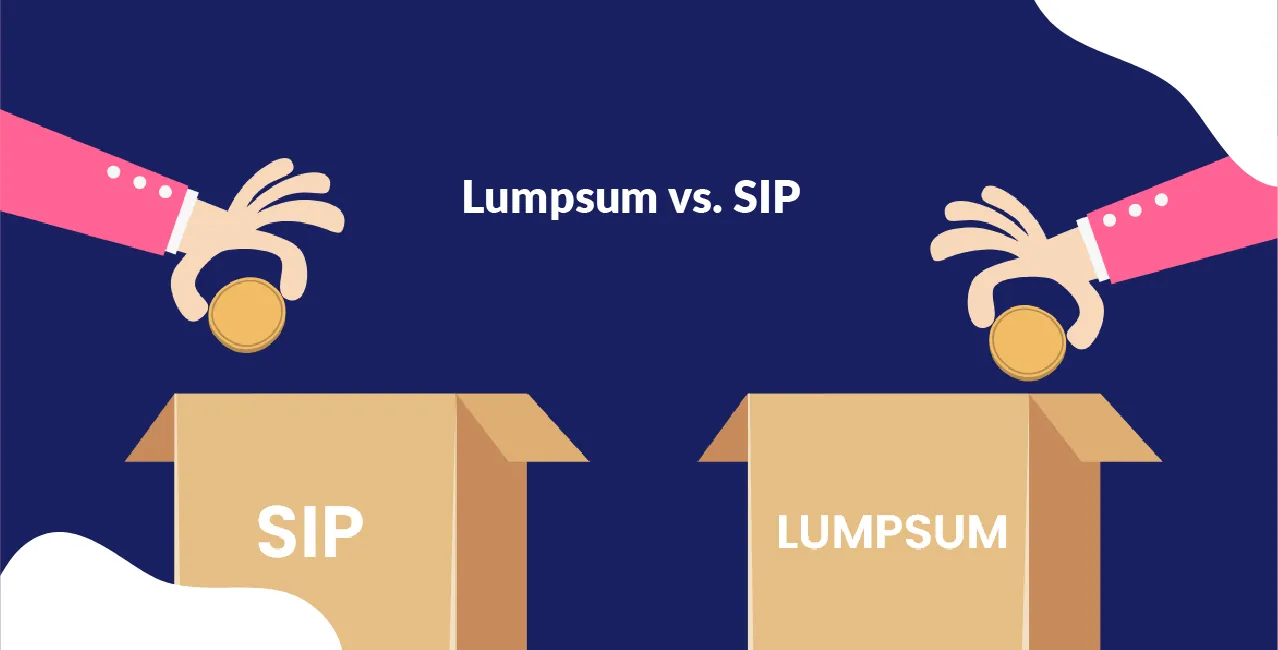
Author
LoansJagat Team
Read Time
4 Min
08 Jul 2025
Lumpsum vs. SIP: What happens if you invest ₹12 Lakhs today vs. ₹10,000 SIP for 10 years?
Ever thought what ₹12,00,000 can become in 10 years? Or what happens if you simply do ₹10,000 every month for the same time?
This single choice can grow or shrink your future money. Which route gives you more wealth? Which is safer? Which one is smarter for the Indian investor?
Money doesn’t just sit. It grows or dies slowly, and how you invest it decides where your future lands.
Let’s compare both styles, lump Sum investment and SIP (Systematic Investment Plan). This isn’t a vague discussion. We use real math, clear examples, four deep tables, and more.
Investing ₹10,000 monthly via SIP for 10 years (total ₹12 lakh) yields returns based on market performance, which can now be compared against a ₹12 lakh lump-sum investment.
How the two styles work?
Before we battle numbers, let’s set the basics right.
Lumpsum means putting the entire amount, ₹12,00,000, into a mutual fund or market in one go.
SIP means breaking it into ₹10,000 monthly investments over 10 years. That’s ₹12,00,000 too.
So, the amount is the same. Only the path is different.
Now let’s dig.
Investment Growth Comparison (₹12,00,000 in each case)
10-Year Corpus at 12% CAGR
You can clearly see the difference. ₹14,00,000 more in 10 years by investing upfront. That’s not pocket change.
Why the gap?
Because time is fuel. In a lump sum, the full money works from Day 1. In SIP, each ₹10,000 gets less and less time to grow. The first month grows for 10 years, and the last month grows for only 1.
Read More - How to Invest in SIP – Step-by-Step Guide for Beginners
Compounding Effect: Not Just Theory
In India, most mutual funds offer an average CAGR of 12–15% over 10+ years. Let’s assume 12% for this post. That’s fair for equity funds, and the Indian market has done even more in bull runs.
Now see this:
SIP Monthly Gains vs. Lump Sum
See the gap widen with every passing year? That’s the power of early compounding.
Example
Ramesh had saved ₹12,00,000 from an ancestral land deal. He parked it in an equity mutual fund.
- Alok had a monthly income. He did ₹10,000 SIPs religiously.
After 10 years?
- Ramesh had ₹37,00,000+
- Alok had ₹23,00,000+
Both invested same ₹12,00,000. The outcome is hugely different.
What about risk and emotions?
This is where many Indian investors get stuck.
SIPs feel safe. They avoid market timing. If market falls, next month’s SIP buys cheaper units. It’s smooth, automated, and suits salaried people.
Lump sum feels scary. “What if market crashes tomorrow?”
Yes. That fear is real. But that’s why people split their lump sum. For example:
- ₹6,00,000 now
- ₹50,000 SIP for 12 months
- Then evaluate
This is called STP (Systematic Transfer Plan)—you shift from a debt fund to an equity fund over months. It controls fear and keeps discipline.
Strategy Mix – Not All or Nothing
What if we combine both styles?
Hybrid Strategy (Split ₹12,00,000)
It beats SIP alone. Not as strong as a full lump sum, but more emotional safety.
Technical Tools You Can Use
Here are some techniques Indian investors use:
- SIP + Step-Up SIP: Increase the SIP amount by 10% each year
- STP (Systematic Transfer Plan): Move a lump sum slowly from liquid to equity
- Goal-Based Investing: Match your investment to future life goals
- Mutual Fund Calculators: Use AMFI, Groww or ET Money apps for live CAGR tracking
Also Read - How to Start SIP Investment – A Step-by-Step Guide for Beginners
Don’t ignore Tax and Inflation.
Even if returns are great, tax will bite.
- Lump Sum gains after 1 year are taxed at 10% LTCG (Long Term Capital Gain)
- SIP gains are taxed per instalment. Each monthly SIP has a 1-year holding period.
Also, consider inflation. ₹1,00,000 today won’t be ₹1,00,000 in 2035. Invest in equity only if your goal is 5+ years away.
Tax Comparison
Conclusion
- If you have ₹12,00,000 and patience, lump sum will beat SIP.
- If you earn monthly, SIP is smart and stress-free.
- If you're unsure, mix them. Half now, half over SIP or STP.
Money grows when you stay invested. Not when you worry or wait.
Don’t chase returns. Stick to a method. Let time and the power of compounding do their job.
FAQs
1. Is SIP better than lump sum in a volatile market?
Yes. SIP smooths out the buying price by rupee-cost averaging. It lowers risk if the market moves up and down often.
2. Can I convert my lump sum into SIP using STP?
Absolutely. Just invest the lump sum into a liquid fund and then use STP to shift to an equity fund over time.
3. Is it okay to start SIP with ₹5,000 only?
Yes. Even ₹500 SIPs are fine to start. What matters more is discipline and consistency over the years.
4. What if I miss a SIP date? Will I lose returns?
No, but avoid missing. Some AMCs skip the month, some retry. Best to keep enough balance in your bank.
5. Which mutual fund is best for lumpsum investment?
Ideally, invest in large-cap or hybrid equity funds for lumpsum. They are more stable than mid or small caps.
Other Related Pages | |||
Why More Indians Are Choosing Gold Loans Over Fixed Deposits in 2025 | |||
About the Author

LoansJagat Team
‘Simplify Finance for Everyone.’ This is the common goal of our team, as we try to explain any topic with relatable examples. From personal to business finance, managing EMIs to becoming debt-free, we do extensive research on each and every parameter, so you don’t have to. Scroll up and have a look at what 15+ years of experience in the BFSI sector looks like.

Quick Apply Loan
Subscribe Now


